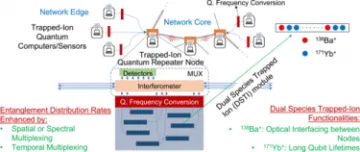Date Published: March 1, 2022
A recent paper was published in the APS Physical Review A by the Guha lab, associated with the Center for Quantum Networks, and was selected as an Editor's Suggestion. The work was funded on the NSF Convergence Accelerator program in collaboration with University of Maryland. The paper discusses trapped-ion based quantum repeaters and was led by Wyant College Ph.D. student, Prajit Dhara, advised by Dr. Saikat Guha and co-advised by Dr. Kaushik Seshadreesan, Assistant Professor at Univ. of Pittsburg. According to the abstract, trapped ions form an advanced technology platform for quantum information processing with long qubit coherence times, high-fidelity quantum logic gates, optically active qubits, and a potential to scale up in size while preserving a high level of connectivity between qubits. These traits make them attractive not only for quantum computing, but also for quantum networking. Dedicated, special-purpose trapped-ion processors in conjunction with suitable interconnecting hardware can be used to form quantum repeaters that enable high-rate quantum communications between distant trapped-ion quantum computers in a network. The group works to consider an architecture for a repeater based on dual-species trapped-ion systems. The results bolster the case for near-term trapped-ion systems as quantum repeaters for long distance quantum communications. Read more in the published paper.

General architecture of a repeater node based on DSTI modules to support entanglement distribution protocols based on mode multiplexing. The lines denote optical fibers.
